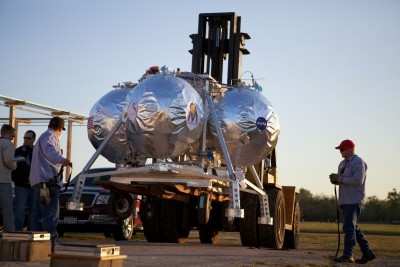Prototype Lander To Be Evaluated For Future Spacecraft
Design
Neighbors of NASA's Johnson Space Center in Houston may notice
some loud noises coming from the 1,600-acre site in the coming
weeks.

Johnson's Engineering Directorate is ready to begin testing its
prototype lander as part of Project Morpheus- a vertical test bed
designed to integrate technologies that could be used to build
future spacecraft intended to land on the moon, Mars, asteroids or
any other foreign surface.
The last time a prototype spacecraft was flown at Johnson, man
hadn't yet landed on the moon. Located as it is in the middle of a
busy urban area, the site isn't suitable as a launch site for the
programs - such as the space shuttle and Apollo - that have called
it home. But for the past 10 months, Johnson engineers have been
working on Morpheus, and now they're ready to put it to the
test.
"Morpheus is tangible proof that we can and are doing amazing
and exciting things advancing exploration systems with a different
paradigm," said Steve Altemus, director of Johnson's engineering
directorate. "Over the past year, with very little funds, by
leveraging our facilities and commercial partners, and most
importantly by unleashing the power of our workforce, we put a
functioning spacecraft together."
Though the schedule is weather dependent, the first Morpheus hot
fire is set for Friday. Engineers will strap the vehicle down in a
field on site, and fire the engine for 5 to 10 seconds. There will
likely be a series of these tests, before the engineers move to
tethered tests, in which the engine is fired while the vehicle is
suspended from a crane.

The buildings closest to the tests, on- or off-site, stand about
2,000 feet away. At that distance, one can expect to hear the
engine firings at a level of about 93 decibels - comparable to
standing next to a lawn mower. If all goes well, the tests will
culminate with Morpheus' first free flight on May 4, as part of
Johnson's Innovation Day activities. That will require the
untethered vehicle to rise almost 100 feet into the air, fly 100
feet to the west and land safely. It's not an exact match for what
the vehicle would be required to do on the moon or another planet
or asteroid, but it allows the engineers to prove safely and
cheaply that the various components of the vehicle work together as
a system.
"In a lot of ways, this is what people came to NASA to do: To
build things, to fly things", Project Morpheus Manager Matt Ondler
said. "So it's a great opportunity to learn how to build things and
fly things."
Morpheus is intended to prove two key technologies that could be
used in future exploration: One, Automated Landing and Hazard
Avoidance Technology, would enable a lander to navigate itself
around rocks, craters and other hazards, and into a safe landing
space. The other is the use of liquid oxygen and methane as a
propellant - these "green" fuels are cheaper and safer to use here
on Earth, and could also be manufactured on the moon or even
Mars.
Both technologies were being studied at Johnson well before
Morpheus began to take shape, but integrating them into one vehicle
allows engineers to verify that they'll work in real life, as well
as in the lab. "When you integrate all the different subsystems,
you really learn a lot that you don't get from doing things
individually in the lab," Ondler said. "So it's important to be
able to do this testing here, to give our workforce the right
hands-on opportunities to become better engineers and more capable
of affordably building NASA's next vehicle."
To ensure that the free flight test could be done safely,
Morpheus has two completely redundant termination systems. It would
take multiple failures for the vehicle to leave its projected
flight path. However, if that were to happen, the vehicle still
would not be able to travel more than about 500 feet in any
direction with the amount of propellant it will have, leaving some
1,500 feet between it and the nearest buildings.
 ANN's Daily Aero-Linx (04.16.24)
ANN's Daily Aero-Linx (04.16.24) Aero-News: Quote of the Day (04.16.24)
Aero-News: Quote of the Day (04.16.24) Airborne 04.10.24: SnF24!, A50 Heritage Reveal, HeliCycle!, Montaer MC-01
Airborne 04.10.24: SnF24!, A50 Heritage Reveal, HeliCycle!, Montaer MC-01 Airborne 04.12.24: SnF24!, G100UL Is Here, Holy Micro, Plane Tags
Airborne 04.12.24: SnF24!, G100UL Is Here, Holy Micro, Plane Tags Airborne-Flight Training 04.17.24: Feds Need Controllers, Spirit Delay, Redbird
Airborne-Flight Training 04.17.24: Feds Need Controllers, Spirit Delay, Redbird




